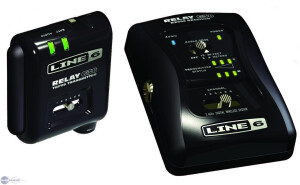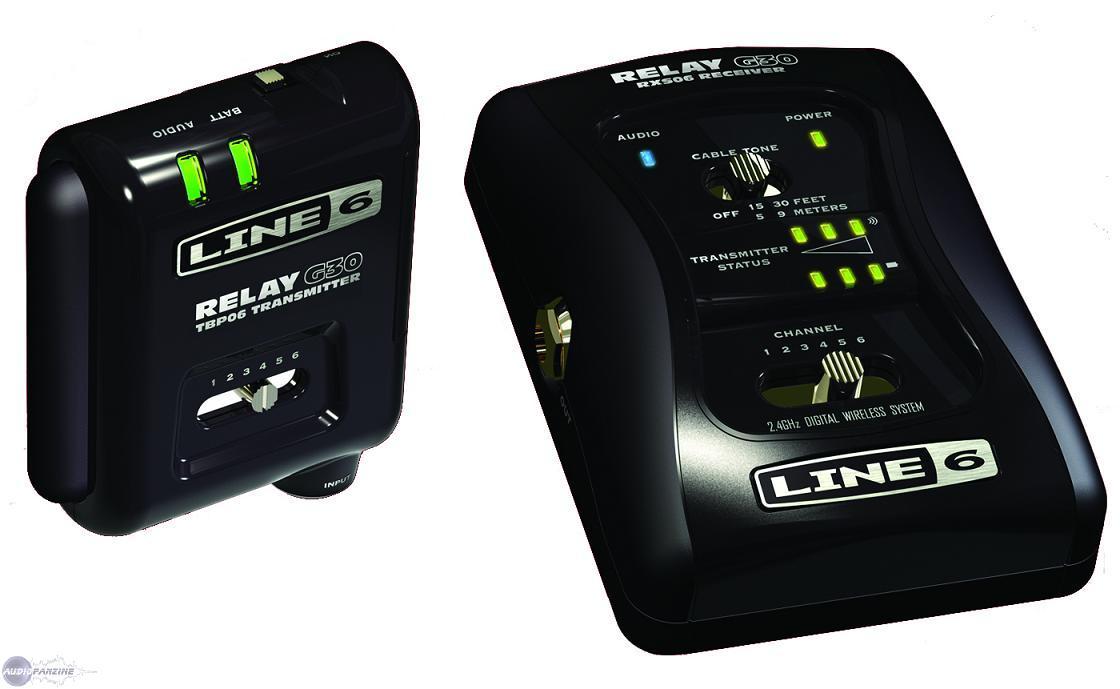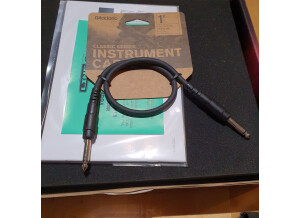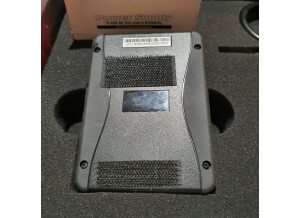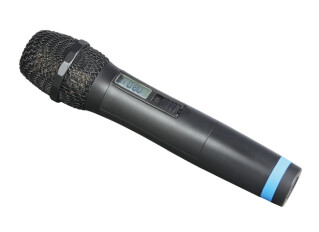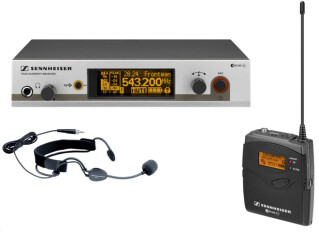Relay G30 classified ad
New ad alertNews
Images
Reviews
4.2/5(23 reviews)
57 %
22 %
4 %
9 %
Write a user review
good sound but poor build quality
Published on 08/02/14 at 06:22I bought two G30 systems..a lot of money for me. The very first time i used first one ,the belt clip FELL OFF..now need velcro strip to secure. On the second one, after three weeks the battery housing latch crumbled and is now secured by a homemade strip of bent metal..not ideal. Pity, because the sound is good..hope the build quality has been improved for future users. Footnote; interesting to see that my original review of this product as stated above , has been REMOVED from the review section ....leaving only grovelling GOOD reviews !!! Anyway, don't care anymore ....what's the point? mm
10
»
The digital wireless revolution is here!!!
Published on 08/23/12 at 14:36This is NOT Spinal Tap
You've either seen it, heard it, or lived it. The freedom of wireless roaming on stage crippled by the interference of local radio stations, other broadcasts, or the wireless from the opening band's guitar player that didn't get turned off after THEIR set (I've actually seen the last one happen). All of these scenarios have led to a small backlash against traditional analog/RF wireless units and have players going back to their tried-and-true cable.
What's in a cable?
If you have the inclination, you can find information on the Internet that bashes guitar cables as "tone suckers" and nothing better than antennas that bleed your guitar tone and introduce...…
You've either seen it, heard it, or lived it. The freedom of wireless roaming on stage crippled by the interference of local radio stations, other broadcasts, or the wireless from the opening band's guitar player that didn't get turned off after THEIR set (I've actually seen the last one happen). All of these scenarios have led to a small backlash against traditional analog/RF wireless units and have players going back to their tried-and-true cable.
What's in a cable?
If you have the inclination, you can find information on the Internet that bashes guitar cables as "tone suckers" and nothing better than antennas that bleed your guitar tone and introduce...…
Read more
This is NOT Spinal Tap
You've either seen it, heard it, or lived it. The freedom of wireless roaming on stage crippled by the interference of local radio stations, other broadcasts, or the wireless from the opening band's guitar player that didn't get turned off after THEIR set (I've actually seen the last one happen). All of these scenarios have led to a small backlash against traditional analog/RF wireless units and have players going back to their tried-and-true cable.
What's in a cable?
If you have the inclination, you can find information on the Internet that bashes guitar cables as "tone suckers" and nothing better than antennas that bleed your guitar tone and introduce interference. While this may be true, many opt for the stability of a cable over the gamble of interference on a wireless. Leave it to Line6 to solve this issue in an incredibly creative way using proven technology. When it comes to wireless, Line6 now has every other company smacking themselves on the forehead and asking, "Now why didn't WE think of that?"
The Relay G30 Digital Wireless Guitar System
Enter the Line6 Relay G30 Digital Wireless Guitar System. Comprised of a small transmitter and receiver, this system that Line6 represents as their entry-level package outperforms most other expensive wireless systems. The design of the G30 is both elegant and practical. The receiver is smaller than most stomp boxes and will fit easily on a pedal board, on top of, and possibly inside the back of most open-backed amps. The internal antennas on the G30 receiver makes it easily mistaken for a stomp box on a pedal board. The transmitter is just big enough for the device itself and the two 'AA' batteries that power the transmitter. Now let's talk about intelligence for a second. When you're playing, you can't see the transmitter that is on your guitar strap, belt, etc. That's why Line6 put the meter that shows the relative strength of the signal (including transmitter battery strength) on the receiver, where you CAN see it at a glance via a row of color-changing LED lights. There is, of course, a battery indicator on the transmitter, but I found myself relying more on what the receiver was telling me than constantly looking over my shoulder.
I had the Relay G30 up and running in about 30 seconds. Put in the batteries, pick one of the six available common "channels" on the receiver and the transmitter, plug in, and play. No messing with antenna positions, no dealing with interference, just pure, true guitar signal getting to your amp. Line6 has accomplished this by using tried-and-true digital wireless technology. This is the same technology you've had in your house for some time now, wirelessly connecting your computers to the internet. The Relay G30 operates over the 2.4 GHz frequency band, the same as most of the older cordless telephone and computer wireless access points.
Given the history of wireless systems and interference, plus the fact that I'm an admitted geek as well as musician, I decided to see if I could make the G30 fail or introduce any interference into the signal. Nope. I even put a famous-maker wireless access point made for computers directly between, beside, over, and under the G30 receiver and never encountered any interference. This is due to a pair of technologies on-board in the G30. First is Digital Channel Locking (DCL) technology that "locks" the transmitter and receiver onto the same signal frequency. The second employs some advanced technology, again borrowed from the computer world, to block out any signal that might try to interfere with YOUR frequency.
But how does it sound?
Once I plugged in the G30 I was amazed at the clarity, quality, and overall fullness of the sound when compared to my cable. In fact, it was a little TOO good. Higher frequencies were popping out all over the place and I thought, "I haven't changed my EQ settings, where did all this treble come from?" Well, it turns out the G30 will transmit all those higher frequencies that your guitar cable doesn't. The specifications on the G30 state its frequency response between 10 Hz and 20 kHz. My first thought was that I would have to adjust my EQ settings to accommodate the new wireless. But wouldn't you know it, Line6 thought of that as well. The G30 has a feature called "Cable Tone Simulation." Basically, this is a three position switch on the receiver that allows you to select how you want the G30 to sound. Your choices are Full Digital, 5 Meter Cable Simulation, or 9 Meter Cable Simulation. Clicking onto the 5 Meter position rolled off a good bit of the high frequencies and my guitar started to sound more like its old self. Clicking onto the 9 Meter position rolled off even MORE of the high frequencies and my thoughts of having to adjust my EQ melted away. As an interesting note, the lowest and highest frequencies listed on my 31-band famous-name EQ are 20 Hz and 20 kHz, so the G30 has got you more than covered. The high-fidelity quality of sound that the G30 produces will have you looking at your guitar and gear in a whole new light.
I was afraid that while I could hear the differences live, I wouldn't be able to capture the differences when recording sound clips. That wasn't the case at all.
I plugged in a variety of guitars and amps using the G30 system including Gibson and Epiphone Les Paul models, Ibanez RG and JEM models, a Fender Lite Ash Telecaster, a PRS SE Semi-hollow, a Mosier MMi-T, and various Squier models. I was treated to the same crystal-clear beautiful tone every time.
Overall, I think the Relay G30 Digital Wireless Guitar System far exceeds any "entry-level" expectations and have a difficult time thinking of it as entry-level on any scale. The signal delivered is pure and true and the Cable Tone Simulation feature means you can gradually adjust your EQ settings until you reach that "full digital" state if desired, or leave it on to shape your tone exactly how you want it. Be forewarned that due to the power needed to maintain good signal strength the transmitter will deplete a standard set of 'AA' batteries after a few hours of playing so either make sure you put in fresh batteries before a gig, or use high-grade Lithium batteries that are specially designed for high-power devices. Either way, if you're standing right in front of the receiver and the signal strength light is showing one red bar instead of 2-3 green bars, change your transmitter batteries. The receiver is powered by the included AC adapter, so you're covered there.
Say good-bye to your cable, bad wireless interference, and anything else that has previously kept you from exploring the rest of the stage, the crowd, the drum riser, or anywhere else within 30 Meters of the receiver.
You've either seen it, heard it, or lived it. The freedom of wireless roaming on stage crippled by the interference of local radio stations, other broadcasts, or the wireless from the opening band's guitar player that didn't get turned off after THEIR set (I've actually seen the last one happen). All of these scenarios have led to a small backlash against traditional analog/RF wireless units and have players going back to their tried-and-true cable.
What's in a cable?
If you have the inclination, you can find information on the Internet that bashes guitar cables as "tone suckers" and nothing better than antennas that bleed your guitar tone and introduce interference. While this may be true, many opt for the stability of a cable over the gamble of interference on a wireless. Leave it to Line6 to solve this issue in an incredibly creative way using proven technology. When it comes to wireless, Line6 now has every other company smacking themselves on the forehead and asking, "Now why didn't WE think of that?"
The Relay G30 Digital Wireless Guitar System
Enter the Line6 Relay G30 Digital Wireless Guitar System. Comprised of a small transmitter and receiver, this system that Line6 represents as their entry-level package outperforms most other expensive wireless systems. The design of the G30 is both elegant and practical. The receiver is smaller than most stomp boxes and will fit easily on a pedal board, on top of, and possibly inside the back of most open-backed amps. The internal antennas on the G30 receiver makes it easily mistaken for a stomp box on a pedal board. The transmitter is just big enough for the device itself and the two 'AA' batteries that power the transmitter. Now let's talk about intelligence for a second. When you're playing, you can't see the transmitter that is on your guitar strap, belt, etc. That's why Line6 put the meter that shows the relative strength of the signal (including transmitter battery strength) on the receiver, where you CAN see it at a glance via a row of color-changing LED lights. There is, of course, a battery indicator on the transmitter, but I found myself relying more on what the receiver was telling me than constantly looking over my shoulder.
I had the Relay G30 up and running in about 30 seconds. Put in the batteries, pick one of the six available common "channels" on the receiver and the transmitter, plug in, and play. No messing with antenna positions, no dealing with interference, just pure, true guitar signal getting to your amp. Line6 has accomplished this by using tried-and-true digital wireless technology. This is the same technology you've had in your house for some time now, wirelessly connecting your computers to the internet. The Relay G30 operates over the 2.4 GHz frequency band, the same as most of the older cordless telephone and computer wireless access points.
Given the history of wireless systems and interference, plus the fact that I'm an admitted geek as well as musician, I decided to see if I could make the G30 fail or introduce any interference into the signal. Nope. I even put a famous-maker wireless access point made for computers directly between, beside, over, and under the G30 receiver and never encountered any interference. This is due to a pair of technologies on-board in the G30. First is Digital Channel Locking (DCL) technology that "locks" the transmitter and receiver onto the same signal frequency. The second employs some advanced technology, again borrowed from the computer world, to block out any signal that might try to interfere with YOUR frequency.
But how does it sound?
Once I plugged in the G30 I was amazed at the clarity, quality, and overall fullness of the sound when compared to my cable. In fact, it was a little TOO good. Higher frequencies were popping out all over the place and I thought, "I haven't changed my EQ settings, where did all this treble come from?" Well, it turns out the G30 will transmit all those higher frequencies that your guitar cable doesn't. The specifications on the G30 state its frequency response between 10 Hz and 20 kHz. My first thought was that I would have to adjust my EQ settings to accommodate the new wireless. But wouldn't you know it, Line6 thought of that as well. The G30 has a feature called "Cable Tone Simulation." Basically, this is a three position switch on the receiver that allows you to select how you want the G30 to sound. Your choices are Full Digital, 5 Meter Cable Simulation, or 9 Meter Cable Simulation. Clicking onto the 5 Meter position rolled off a good bit of the high frequencies and my guitar started to sound more like its old self. Clicking onto the 9 Meter position rolled off even MORE of the high frequencies and my thoughts of having to adjust my EQ melted away. As an interesting note, the lowest and highest frequencies listed on my 31-band famous-name EQ are 20 Hz and 20 kHz, so the G30 has got you more than covered. The high-fidelity quality of sound that the G30 produces will have you looking at your guitar and gear in a whole new light.
I was afraid that while I could hear the differences live, I wouldn't be able to capture the differences when recording sound clips. That wasn't the case at all.
I plugged in a variety of guitars and amps using the G30 system including Gibson and Epiphone Les Paul models, Ibanez RG and JEM models, a Fender Lite Ash Telecaster, a PRS SE Semi-hollow, a Mosier MMi-T, and various Squier models. I was treated to the same crystal-clear beautiful tone every time.
Overall, I think the Relay G30 Digital Wireless Guitar System far exceeds any "entry-level" expectations and have a difficult time thinking of it as entry-level on any scale. The signal delivered is pure and true and the Cable Tone Simulation feature means you can gradually adjust your EQ settings until you reach that "full digital" state if desired, or leave it on to shape your tone exactly how you want it. Be forewarned that due to the power needed to maintain good signal strength the transmitter will deplete a standard set of 'AA' batteries after a few hours of playing so either make sure you put in fresh batteries before a gig, or use high-grade Lithium batteries that are specially designed for high-power devices. Either way, if you're standing right in front of the receiver and the signal strength light is showing one red bar instead of 2-3 green bars, change your transmitter batteries. The receiver is powered by the included AC adapter, so you're covered there.
Say good-bye to your cable, bad wireless interference, and anything else that has previously kept you from exploring the rest of the stage, the crowd, the drum riser, or anywhere else within 30 Meters of the receiver.
See less
00
»
ok...
Published on 01/10/12 at 15:26This is the only wireless I've ever owned, and I purchased it because it was the smallest transmitter available. I didn't want a big bulky pager sized device connected to my strap because, when I played live, I would throw my guitar around my neck and do other tricks. I wanted to be able to go wireless so I could run around more easily without having to worry where the slack guitar cable was going.
The quality of the transmission/reception to the guitar amplifier is good, but understand that playing through a wireless will always degrade the quality of the tone somewhat, particularly in the area of sustain. There are squelch and volume controls on the receiver to fiddle around with,...…
Read more
This is the only wireless I've ever owned, and I purchased it because it was the smallest transmitter available. I didn't want a big bulky pager sized device connected to my strap because, when I played live, I would throw my guitar around my neck and do other tricks. I wanted to be able to go wireless so I could run around more easily without having to worry where the slack guitar cable was going.
The quality of the transmission/reception to the guitar amplifier is good, but understand that playing through a wireless will always degrade the quality of the tone somewhat, particularly in the area of sustain. There are squelch and volume controls on the receiver to fiddle around with, but it takes a little getting used to playing with a slightly duller tone. Changing the EQ and presence controls on the amplifier can help in achieving the tone that's been lost through the wireless set.
Another benefit of using a wireless guitar is that it cuts down on the risk of electrocution. Some clubs have funky power, or don't have all the lines grounded properly, so playing a corded guitar and touching the microphone (by the hand or with wet lips) can produce a shocking surprise. Playing with a wireless set directly takes out one major component of this equation as the guitar is not physically connected by any cables to the amplifier, cutting down on this risk of grounding fiascos.
I would save my wireless set for some shows... I've always been of the mentality that with the less gear I use, the less likely equipment is to fail. But, since the time I've bought it, FCC rules have changed and it is illegal to use my wireless set as it broadcasts on a banned channel. Overall, it’s a decent transmitter but there are way better ones on the market for a better price.
See less
00
»
Line 6 does it again!
Published on 03/23/11 at 08:12Say what you want about Line 6 products. A good amount of the gear that they put out seems to be marketed toward beginners or non-gigging musicians. I've owned a few of their amps and effects. Some were usable while others were just plain bad.
I decided to take a chance on the Line 6 Relay 30 wireless system after having sent back a Brace Audio unit. I went into this blind...not knowing anyone personally who had one that I could try out. The size of the unit is great! Very compact and light. The receiver mounted on my pedalboard and is about the size of a large stompbox. The transmitter is one of the smallest that I've seen.
The transmitter runs on 2 AA batteries which are MUCH cheaper...…
I decided to take a chance on the Line 6 Relay 30 wireless system after having sent back a Brace Audio unit. I went into this blind...not knowing anyone personally who had one that I could try out. The size of the unit is great! Very compact and light. The receiver mounted on my pedalboard and is about the size of a large stompbox. The transmitter is one of the smallest that I've seen.
The transmitter runs on 2 AA batteries which are MUCH cheaper...…
Read more
Say what you want about Line 6 products. A good amount of the gear that they put out seems to be marketed toward beginners or non-gigging musicians. I've owned a few of their amps and effects. Some were usable while others were just plain bad.
I decided to take a chance on the Line 6 Relay 30 wireless system after having sent back a Brace Audio unit. I went into this blind...not knowing anyone personally who had one that I could try out. The size of the unit is great! Very compact and light. The receiver mounted on my pedalboard and is about the size of a large stompbox. The transmitter is one of the smallest that I've seen.
The transmitter runs on 2 AA batteries which are MUCH cheaper in my area than 9 volts. They also seem to last a great deal longer. I can usually get through 4 or so 90 minute sets and still have juice left in it. There's also a great feature that is supposed to mimic as if your guitar is still using a cable and not a wireless. I can hear the slight difference when using this feature.
I went with the relay 30 over the 50 or 90 because I don't really play arena or stadium sized stages. The 30 is more than enough for the average club musician. The 30 is working in the 2.4 GHz freq. not in the 900 Mhz freq. range. It has never cut out on me and I've gone past the 30 meters it touts itself as.
I recently added a Voodoo Labs Pedal Power 2+ power source to my board and according to Voodoo, I was able to power the G30 Relay using one of the standard cables...it was a HUGE relief...no more wall wart!
I recommend this product to any guitar or bass player out there looking for a budget friendly, but PRO, wireless solution. You won't regret it.
I decided to take a chance on the Line 6 Relay 30 wireless system after having sent back a Brace Audio unit. I went into this blind...not knowing anyone personally who had one that I could try out. The size of the unit is great! Very compact and light. The receiver mounted on my pedalboard and is about the size of a large stompbox. The transmitter is one of the smallest that I've seen.
The transmitter runs on 2 AA batteries which are MUCH cheaper in my area than 9 volts. They also seem to last a great deal longer. I can usually get through 4 or so 90 minute sets and still have juice left in it. There's also a great feature that is supposed to mimic as if your guitar is still using a cable and not a wireless. I can hear the slight difference when using this feature.
I went with the relay 30 over the 50 or 90 because I don't really play arena or stadium sized stages. The 30 is more than enough for the average club musician. The 30 is working in the 2.4 GHz freq. not in the 900 Mhz freq. range. It has never cut out on me and I've gone past the 30 meters it touts itself as.
I recently added a Voodoo Labs Pedal Power 2+ power source to my board and according to Voodoo, I was able to power the G30 Relay using one of the standard cables...it was a HUGE relief...no more wall wart!
I recommend this product to any guitar or bass player out there looking for a budget friendly, but PRO, wireless solution. You won't regret it.
See less
00
»
Tech. sheet
- Manufacturer: Line 6
- Model: Relay G30
- Series: Relay
- Category: Wireless systems
- Package weight:829 g
- Added in our database on: 03/31/2009
We have no technical specifications for this product
but your help will be much welcomed
»
Manuals and other files
Other categories in Wireless gear
Other names: relayg30, relay g 30


